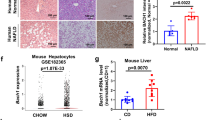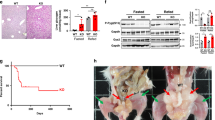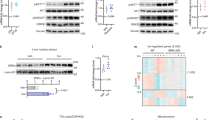Abstract
Insulin receptor substrate-1 (IRS-1) and IRS-2 are known to transduce and amplify signals emanating from the insulin receptor1,2,3. Here we show that Grb2-associated binder 1 (Gab1), despite its structural similarity to IRS proteins4, is a negative modulator of hepatic insulin action. Liver-specific Gab1 knockout (LGKO) mice showed enhanced hepatic insulin sensitivity with reduced glycemia and improved glucose tolerance. In LGKO liver, basal and insulin-stimulated tyrosine phosphorylation of IRS-1 and IRS-2 was elevated, accompanied by enhanced Akt/PKB activation. Conversely, Erk activation by insulin was suppressed in LGKO liver, leading to defective IRS-1 Ser612 phosphorylation. Thus, Gab1 acts to attenuate, through promotion of the Erk pathway, insulin-elicited signals flowing through IRS and Akt proteins, which represents a novel balancing mechanism for control of insulin signal strength in the liver.
This is a preview of subscription content, access via your institution
Access options
Subscribe to this journal
Receive 12 print issues and online access
$209.00 per year
only $17.42 per issue
Buy this article
- Purchase on Springer Link
- Instant access to full article PDF
Prices may be subject to local taxes which are calculated during checkout




Similar content being viewed by others
References
Tamemoto, H. et al. Insulin resistance and growth retardation in mice lacking insulin receptor substrate-1. Nature 372, 182–186 (1994).
Araki, E. et al. Alternative pathway of insulin signalling in mice with targeted disruption of the IRS-1 gene. Nature 372, 186–190 (1994).
Withers, D.J. et al. Disruption of IRS-2 causes type 2 diabetes in mice. Nature 391, 900–904 (1998).
Holgado-Madruga, M., Emlet, D.R., Moscatello, D.K., Godwin, A.K. & Wong, A.J. A Grb2-associated docking protein in EGF- and insulin-receptor signalling. Nature 379, 560–564 (1996).
Michael, M.D. et al. Loss of insulin signalling in hepatocytes leads to severe insulin resistance and progressive hepatic dysfunction. Mol. Cell 6, 87–97 (2000).
Saltiel, A.R. & Kahn, C.R. Insulin signalling and the regulation of glucose and lipid metabolism. Nature 414, 799–806 (2001).
Elchebly, M. et al. Increased insulin sensitivity and obesity resistance in mice lacking the protein tyrosine phosphatase-1B gene. Science 283, 1544–1548 (1999).
Clement, S. et al. The lipid phosphatase SHIP2 controls insulin sensitivity. Nature 409, 92–97 (2001).
Gu, H. & Neel, B.G. The “Gab” in signal transduction. Trends Cell Biol. 13, 122–130 (2003).
Itoh, M. et al. Role of Gab1 in heart, placenta, and skin development and growth factor- and cytokine-induced extracellular signal-regulated kinase mitogen-activated protein kinase activation. Mol. Cell. Biol. 20, 3695–3704 (2000).
Sachs, M. et al. Essential role of Gab1 for signalling by the c-Met receptor in vivo. J. Cell Biol. 150, 1375–1384 (2000).
Rocchi, S. et al. Determination of Gab1 (Grb2-associated binder-1) interaction with insulin receptor-signalling molecules. Mol. Endocrinol. 12, 914–923 (1998).
Postic, C. & Magnuson, M.A. DNA excision in liver by an albumin-Cre transgene occurs progressively with age. Genesis 26, 149–150 (2000).
Postic, C. et al. Dual roles for glucokinase in glucose homeostasis as determined by liver and pancreatic beta cell-specific gene knock-outs using Cre recombinase. J. Biol. Chem. 274, 305–315 (1999).
Jiang, Z.Y. et al. Insulin signalling through Akt/protein kinase B analyzed by small interfering RNA-mediated gene silencing. Proc. Natl. Acad. Sci. USA 100, 7569–7574 (2003).
Krook, A., Roth, R.A., Jiang, X.J., Zierath, J.R. & Wallberg-Henriksson, H. Insulin-stimulated Akt kinase activity is reduced in skeletal muscle from NIDDM subjects. Diabetes 47, 1281–1286 (1998).
Summers, S.A. & Birnbaum, M.J. A role for the serine/threonine kinase, Akt, in insulin-stimulated glucose uptake. Biochem. Soc. Trans. 25, 981–988 (1997).
Cho, H. et al. Insulin resistance and a diabetes mellitus-like syndrome in mice lacking the protein kinase Akt2 (PKB beta). Science 292, 1728–1731 (2001).
Mothe, I. & Van Obberghen, E. Phosphorylation of insulin receptor substrate-1 on multiple serine residues, 612, 632, 662, and 731, modulates insulin action. J. Biol. Chem. 271, 11222–11227 (1996).
De Fea, K. & Roth, R.A. Protein kinase C modulation of insulin receptor substrate-1 tyrosine phosphorylation requires serine 612. Biochemistry 36, 12939–12947 (1997).
De Fea, K. & Roth, R.A. Modulation of insulin receptor substrate-1 tyrosine phosphorylation and function by mitogen-activated protein kinase. J. Biol. Chem. 272, 31400–31406 (1997).
Fruman, D.A. et al. Hypoglycaemia, liver necrosis and perinatal death in mice lacking all isoforms of phosphoinositide 3-kinase p85 alpha. Nat. Genet. 26, 379–382 (2000).
Ueki, K. et al. Positive and negative roles of p85alpha and p85beta regulatory subunits of phosphoinositide 3-kinase in insulin signalling. J. Biol. Chem. 278, 48453–48466 (2003).
Terauchi, Y. et al. Increased insulin sensitivity and hypoglycaemia in mice lacking the p85 alpha subunit of phosphoinositide 3-kinase. Nat. Genet. 21, 230–235 (1999).
Dubois, M., Gilles, K.A., Hamilton, J.K., Rebers, P.A. & Smith, F.J. Colorimetri method for the determination of sugars and related substances. Anal. Chem. 28, 350–356 (1956).
Frayn, K.N. & Maycock, P.F. Skeletal muscle triacylglycerol in the rat: methods for sampling and measurement, and studies of biological variability. J. Lipid Res. 21, 139–144 (1980).
Miles, P.D., Barak, Y., He, W., Evans, R.M. & Olefsky, J.M. Improved insulin-sensitivity in mice heterozygous for PPAR-gamma deficiency. J. Clin. Invest. 105, 287–392 (2000).
Revers, R.R., Fink, R., Griffin, J., Olefsky, J.M. & Kolterman, O.G. Influence of hyperglycemia on insulin's in vivo effects in type II diabetes. J. Clin. Invest. 73, 664–672 (1984).
Steele, R. Influences of glucose loading and of injected insulin on hepatic glucose output. Ann. NY Acad. Sci. 82, 420–430 (1959).
Sun, Y. et al. Role of Gab1 in UV-induced c-Jun NH2-terminal kinase activation and cell apoptosis. Mol. Cell. Biol. 24, 1531–1539 (2004).
Acknowledgements
We thank R. Premont for triple-loxP constructs, M. White for antibodies to IRS-1 and IRS-2, R. Abraham for providing the lactate kit, and colleagues for discussion. This work was supported by US National Institutes of Health grants DK60484 to A.L.H., DK33651 to J.M.O. and GM53660 to G.S.F. G.S.F. was a recipient of a career development award from the American Diabetes Association.
Author information
Authors and Affiliations
Corresponding author
Ethics declarations
Competing interests
The authors declare no competing financial interests.
Supplementary information
Supplementary Fig. 1
Insulin-induced tyrosine phosphorylation of IRβ in LGKO liver. (PDF 57 kb)
Supplementary Fig. 2
Normal expression levels of proteins involved in insulin signalling. (PDF 48 kb)
Supplementary Fig. 3
Deletion of Gab1 leads to enhanced insulin signalling through IRS-1, -2 in hepatocytes. (PDF 49 kb)
Supplementary Table 1
Characteristics of mutant mice at 2 and 12 months of age (PDF 20 kb)
Rights and permissions
About this article
Cite this article
Bard-Chapeau, E., Hevener, A., Long, S. et al. Deletion of Gab1 in the liver leads to enhanced glucose tolerance and improved hepatic insulin action. Nat Med 11, 567–571 (2005). https://doi.org/10.1038/nm1227
Received:
Accepted:
Published:
Issue Date:
DOI: https://doi.org/10.1038/nm1227
This article is cited by
-
Gab2 deficiency suppresses high-fat diet-induced obesity by reducing adipose tissue inflammation and increasing brown adipose function in mice
Cell Death & Disease (2021)
-
Insulin receptor endocytosis in the pathophysiology of insulin resistance
Experimental & Molecular Medicine (2020)
-
The epigenetic landscape of transgenerational acclimation to ocean warming
Nature Climate Change (2018)
-
Scaffolding protein Gab1 regulates myeloid dendritic cell migration in allergic asthma
Cell Research (2016)
-
Cardiac Gab1 deletion leads to dilated cardiomyopathy associated with mitochondrial damage and cardiomyocyte apoptosis
Cell Death & Differentiation (2016)



